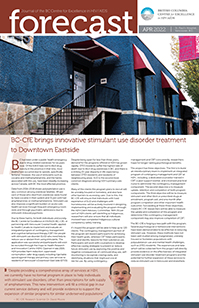
BC has been under a public health emergency due to drug-related overdoses for six years now. Of the 9,400 lives lost to illicit drug toxicity in the province in that time, most deaths have occurred due to opioids, specifically fentanyl. However, the use of stimulants such as cocaine and methamphetamine, and the harms associated with this use, have been steadily increasing across Canada, with BC the most affected province.
Data from 2016-2018 shows polysubstance use is very common among overdose fatalities. 49 per cent of those who died from overdoses were found to have cocaine in their system and 31 per cent had amphetamines or methamphetamine. Stimulant use also imposes a significant burden on acute care health services through frequent emergency room visits and through psychiatric admissions due to stimulant-induced psychosis.
Due to these harms, for both individuals and society, the BC Centre for Excellence in HIV/AIDS (BC-CfE), in partnership with Vancouver Coastal Health, applied to Health Canada to implement and evaluate an integrated program of contingency management and cognitive behavioural therapy (CBT) for people with stimulant use disorder (SUD) who need help to reduce use or abstain from using stimulants. The application was successful and participants will soon be recruited through the Hope to Health Research and Innovation Centre (H2H). Opened in late 2019, H2H provides harm reduction, supervised consumption, safer drug supply including injectable opioid agonist therapy and primary care services to residents of Vancouver’s Downtown East Side (DTES).
Despite being open for less than three years, demand for the programs offered at H2H has grown rapidly. DTES residents suffer the highest rate of death due to illicit drug overdoses in BC, and there is a striking 15-year disparity in life expectancy between DTES residents and residents of neighbouring areas. SUD is the second most common diagnosis among H2H’s primary care clients.
Many of the clients this program plans to recruit will be unstably housed or homeless, and also face other barriers to accessing care. Due to this, the BC-CfE will ensure that individuals with lived experience of SUD and challenges with homelessness will be actively involved in designing, implementing and evaluating the program through the H2H Client Advisory Committee. With 30 per cent of H2H clients self-identifing as Indigenous, researchers will also ensure that all individuals involved have completed Indigenous cultural competency safety training.
It’s hoped the program will be able to help up to 120 clients. The contingency management portion of the program will reward participants for achieving their health goals, whereas CBT helps participants learn and identify reasons for their substance use. Participants will work with counsellors to develop effective coping strategies to prevent or reduce future stimulant use by exploring the positive and negative consequences of continued drug use, self-monitoring to recognize cravings early, and identifying situations that might put one at risk for use. By using contingency management and CBT concurrently, researchers hope for longer-lasting psychological benefits.
The project has three objectives. The first is to build an interdisciplinary team to implement an integrated program of contingency management and CBT at H2H, including a dedicated counsellor trained in CBT, a peer support worker, and a licensed practical nurse to administer the contingency management component. The second objective is to measure uptake, retention and completion of both program components. The third objective will be to measure stimulant and other illicit or prescribed drugs at enrollment, program exit, and one month after program completion and other important health outcomes. Succeeding at these three objectives, means BC-CfE researchers will be able to measure the uptake and completion of this program and determine if the contingency management component may also improve completion of CBT.
The BC-CfE is forging a new path with this program. Several psychological or behavioural interventions have been demonstrated to be effective in reducing stimulant use. However, these methods have not been well studied among marginalized, unstably housed or homeless populations with polysubstance-use and mental health challenges, such as DTES residents. The experiences and data which will be collected from this project will directly provide evidence on the effectiveness of integrated stimulant use disorder treatment programs and the potential for further expansion of these services to reduce stimulant use in Vancouver and elsewhere.

